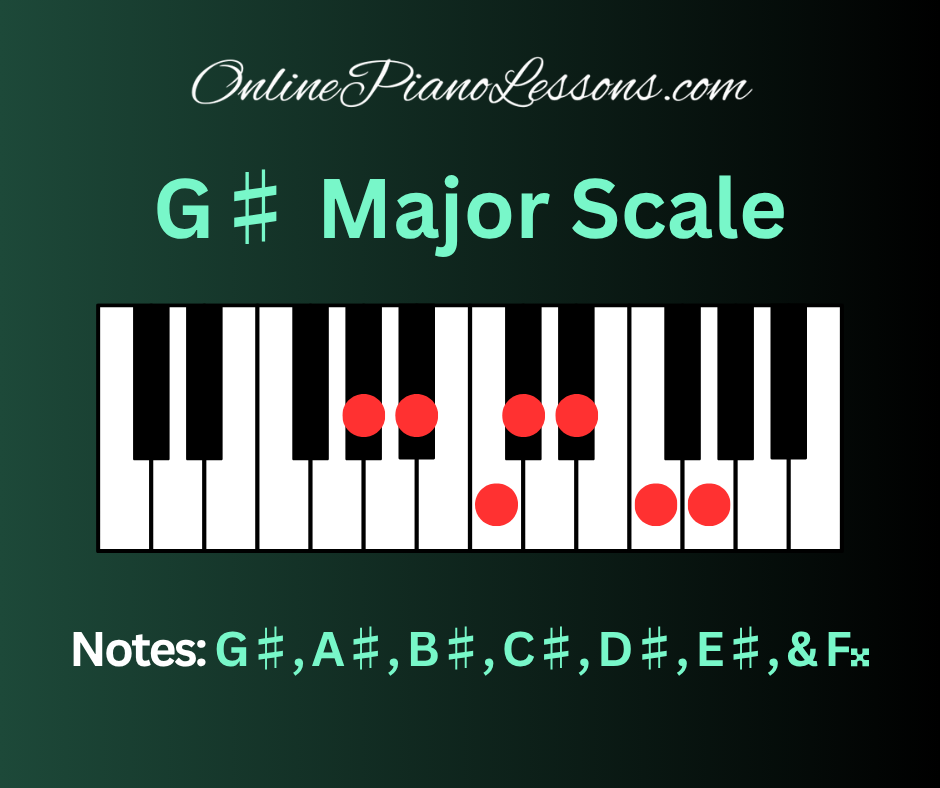
The G sharp major scale is an intriguing entry in the world of scales. Written as G♯, A♯, B♯, C♯, D♯, E♯, and F𝄪, the G♯ major scale looks complex on paper because it uses double sharps and uncommon spellings. On the piano it sounds identical to A♭ major, yet the G♯ major scale has important theoretical uses—especially in analysis, modulation, and contexts that demand consistent letter-name logic. This guide walks you through everything pianists and theorists should know about the G sharp major scale and how it functions on the piano.
Quick Preview: The G sharp major scale (G♯, A♯, B♯, C♯, D♯, E♯, F𝄪) is a theoretically correct but rarely written key that’s enharmonically equivalent to A♭ major on the piano. This definitive guide explains what the G sharp major scale is, how to find and play it on the piano, its theoretical implications, chordal content, practical fingering, and why studying this scale deepens your understanding of enharmonic notation and advanced harmony.
What Is The G Sharp Major Scale?
The G sharp major scale is a major diatonic scale built by applying the major scale formula (whole, whole, half, whole, whole, whole, half) starting from G♯. Notated correctly, the scale’s degrees are:
- 1 (tonic) — G♯
- 2 (supertonic) — A♯
- 3 (mediant) — B♯
- 4 (subdominant) — C♯
- 5 (dominant) — D♯
- 6 (submediant) — E♯
- 7 (leading tone) — F𝄪
- 8 (octave) — G♯
Although the G♯ major scale sounds identical to the A♭ major scale on a modern equal-tempered piano, its spelling ensures every scale degree uses a unique letter name (A–G once each), a requirement in formal music notation and some theoretical contexts.
How To Find The G Sharp Major Scale On The Piano
Finding and playing the G♯ major scale on the piano is straightforward because its pitches coincide with the A♭ major scale enharmonically. To play it physically:
- Locate the G♯ key (the black key immediately to the right of G).
- Ascend: play G♯ (black) → A♯ (black) → B♯ (white key C) → C♯ (black) → D♯ (black) → E♯ (white key F) → F𝄪 (white key G) → G♯ (black octave).
- Descend using the reverse fingering and hand shape.
Despite the unusual notation (B♯, E♯, and F𝄪), the actual keys you depress on the piano are typical white and black keys that many pianists already know from A♭ major practice.
Sound And Character
On the piano, the G♯ major scale sounds bright, stable, and consonant in the same way as any major scale. Because it is enharmonic to A♭ major, its sonic identity is identical to A♭ major’s warm, mellow major color. However, the theoretical label G♯ major carries different implications. Composers and analysts reading a passage spelled in G♯ major expect harmonic relationships (such as leading tones and chord roots) to be spelled with sharps and double sharps, which can clarify modulations from sharp keys or preserve voice-leading logic in certain notational environments.
Key Signature And Notation
If you attempted to write the G♯ major scale as a conventional key signature, you would require eight sharps—one of which is a double-sharp—making it impractical in standard engraving. For this reason, composers virtually always use A♭ major notation in practice. Nevertheless, understanding how the G♯ major scale is spelled is valuable for theoretical precision, especially when dealing with enharmonic modulations or analytic discussions that favor a sharp-based spelling.
Chords Built From The G Sharp Major Scale
Harmonizing the G♯ major scale yields the expected diatonic triads and seventh chords, spelled to maintain unique letter names:
Triads (basic triads):
- I — G♯ major (G♯–B♯–D♯)
- ii — A♯ minor (A♯–C♯–E♯)
- iii — B♯ minor (B♯–D♯–F𝄪)
- IV — C♯ major (C♯–E♯–G♯)
- V — D♯ major (D♯–F𝄪–A♯)
- vi — E♯ minor (E♯–G♯–B♯)
- vii° — F𝄪 diminished (F𝄪–A♯–C♯)
Seventh chord extensions follow the same logic (Imaj7 = G♯–B♯–D♯–F𝄪, etc.). Playing these on the piano is identical to playing the same harmonic textures in A♭ major, but the spellings are important for theoretical analysis and for preserving consistent voice-leading in complex scores.
Practical Fingering For The Piano
Because the G♯ major scale maps to familiar keys, you can use standard fingerings that match A♭ major patterns while speaking the sharped names aloud if you’re practicing notation. One-octave fingering suggestions:
Right hand: 1–2–3–1–2–3–4–5
Left hand: 5–4–3–2–1–3–2–1
For two-octave practice and technical development, adapt the fingering to your hand size, ensuring smooth thumb crossings at the white-key positions (B♯ = C and E♯ = F) where the thumb typically passes under or over as required.
Modes, Relative Minor, And Enharmonic Context
The relative minor of the G♯ major scale is E♯ minor (enharmonically F minor). Modes derived from the G♯ major scale follow the usual major-mode modal sequence (Ionian through Locrian) but use the theoretical spellings (A♯ Dorian, B♯ Phrygian, etc.). In harmonic analysis, G♯ major often serves as a sharp-side relative in modulations and can appear as a theoretical pivot when music moves between remote keys.
Understanding the G♯ major scale deepens awareness of enharmonic equivalence: many keyboard works, especially in modulation-heavy Romantic repertoire or modern tonal writing, rely on enharmonic spellings to clarify harmonic intent. Recognizing when a passage is best thought of as G♯ major versus A♭ major can reveal the composer’s voice-leading goals.
Practice Tips For Pianists
- Practice the G♯ major scale as if it were A♭ major on the piano, but occasionally spell and write the notes using G♯ notation to train both ear and theoretical fluency.
- Play diatonic triads and seventh chords in all inversions; this will make harmonic patterns feel automatic.
- Practice common progressions (I–IV–V–I, ii–V–I) in G♯ major on the piano to internalize the scale’s functional harmony.
- Sight-read short excerpts written in sharp-based spellings to become comfortable reading B♯ and E♯ in context.
- Use harmonic analysis exercises: label chord roots and functions using G♯ major spellings to reinforce spelling discipline.
When Would You Use G Sharp Major Notation?
In practice, G♯ major notation is rare. Composers and engravers choose A♭ major for readability. However, G♯ major notation appears in theoretical discussions, analytic demonstrations, and in scores where a composer is modulating through successive sharp keys and wishes to preserve consistent letter-name relationships. Learning the G♯ major scale trains you to think flexibly about enharmonic spellings and makes advanced analysis and transcription easier.
Conclusion
The G sharp major scale is a theoretically important but practically rare key on the piano. While it sounds identical to A♭ major, its spelled form (G♯, A♯, B♯, C♯, D♯, E♯, F𝄪) enforces one-letter-per-degree logic, which matters in analysis, modulation, and compositional clarity.
For pianists, studying the G♯ major scale enhances notation literacy, deepens harmonic understanding, and sharpens sight-reading skills when dealing with sharp-based spellings. Whether you memorize its theoretical chords, practice its fingerings on the keyboard, or simply study its enharmonic relationships, the G♯ major scale rewards deeper musical thinking.
FAQ
What notes are in the G sharp major scale?
The G♯ major scale is spelled G♯, A♯, B♯, C♯, D♯, E♯, and F𝄪.
Is the G♯ major scale the same as A♭ major on the piano?
Yes, they are enharmonic equivalents—meaning they sound the same on a modern piano—but they are written differently. G♯ major uses sharps and a double-sharp; A♭ major uses flats.
Why is G♯ major rarely written in music?
Because its notation involves double-sharps and many accidentals, making it harder to read. Composers usually prefer A♭ major for practical readability.
How do I practice the G♯ major scale on piano?
Practice it physically like A♭ major, use the suggested fingering, and occasionally write and analyze passages using G♯ notation to reinforce theoretical fluency.
When might I encounter G♯ major notation?
Primarily in theoretical contexts, analysis, or in scores where composers modulate through sharp keys and choose to preserve consistent letter naming rather than shifting to flat-based notation.





 Hi, I'm Thomas, Pianist Composer,
Hi, I'm Thomas, Pianist Composer,  I love playing piano, creating new melodies and songs, and further developing my online piano course and making updates/additions to my site OnlinePianoLessons.com!
I love playing piano, creating new melodies and songs, and further developing my online piano course and making updates/additions to my site OnlinePianoLessons.com!  Now that is what I call fun!
Now that is what I call fun!





